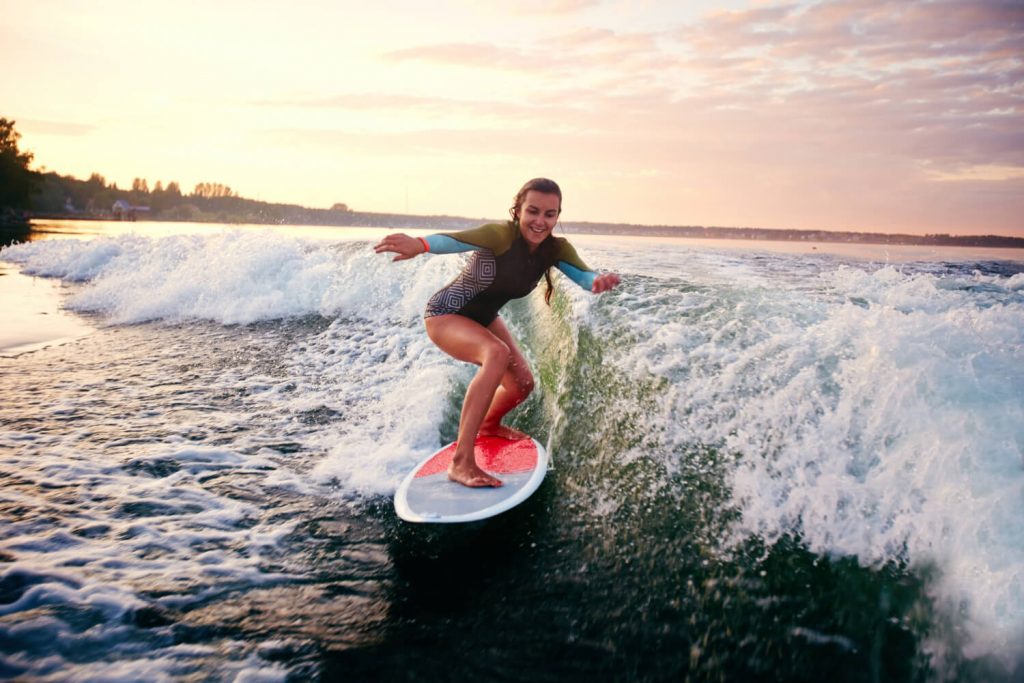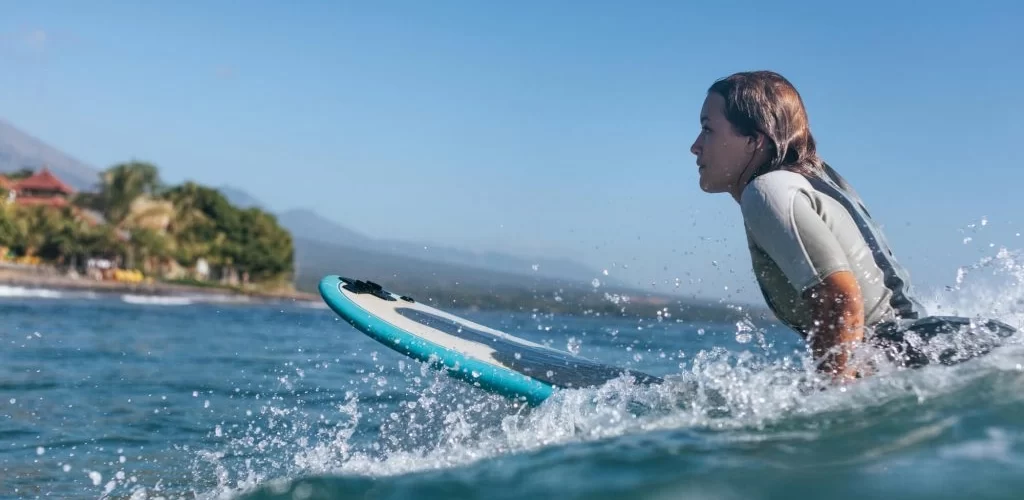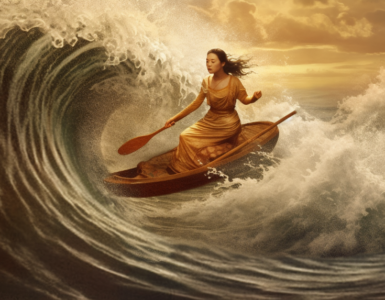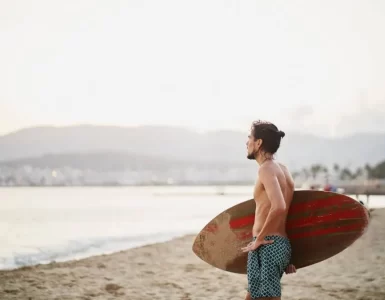Catching a wave seems so easy when you watch from the shore or the television. You might think all you need is guts and a board to be able to ride the waves but surfing is more than that. But that doesn’t mean it’s impossible. In fact, it’s pretty easy to start surfing as long as you are willing to learn.
It helps if you can take classes or have someone to learn from plus take all of the surfing tips you can get. In no time, you’ll be balancing on a surfboard, feeling the thrill of moving towards the shore. Give this a read if you are a beginner who wants to start surfing.
Before the Surfing Begins
Don’t get too excited, before taking a dip into the water, there are some things you need to prepare for first on dry land. Here are some things you will need for your surfing trip:
What to Wear
You might think you’ll look totally hot in just swim shorts or a bikini but covering up is for your own good. It’s best to wear a rash guard to keep your skin from burning in the sun. At the same time, a rash guard can also prevent chafing on your stomach.
Make sure that your bottoms are snug and tight, you wouldn’t want to flash an entire beach as you struggle to stand on your board. If you are going to a beach with a colder climate, it’s best to wear a wetsuit.
Choosing a Board
The two main ingredients of surfing are the board and the waves. You can’t really have that much of a choice with waves, what the ocean gives, that’s what you take. However, when it comes to the board, you are going to need one that you will be comfortable with. Using the wrong board can lead to a frustrating experience.
Shiny surfboards really look cool but as a beginner, it’s not really a practical make. Be sure to choose a surfboard that is made out of foam. You’ll definitely be challenged with balancing and you can’t avoid slipping and sliding off of your board. You wouldn’t want to bang your head on a shiny but hard piece of wood now.
There are a wide range of surfboards available but if you are a beginner, you might want to stick with the first two:
Longboard
You might be surprised to find that a longboard is generally the best type of board for a beginner. It is about 8 to 10 feet long and has a rounded nose and tail. Longer surfboards can offer better stability, which can help you with your balance. What’s more, a long surfboard is also more buoyant making it easy to catch waves and paddle.
Another reason why you should choose a longboard as a beginner is this type of board can go on small waves. It is definitely a good idea for beginners to start riding small waves first before going for big ones.
Funboard
A bit shorter than a longboard, the funboard is around 7 to 8 feet long. It is easier to maneuver than the longboard and at the same time easier to paddle with than the shortboard.
Shortboard
Once you get the hang of surfing and craving a little bit of speed, the shortboard is your best bet. This board is about 5 to 7 feet long and offers amazing performance, speed, and turns on larger waves.
Gun
If you regularly watch surging competitions, you might be more familiar with the shape of the gun surfboard. It has a pointed nose and is 8 to 9 feet long, definitely built for riding big waves.

What to Bring
Aside from the surfboard, you are going to need the following essentials too:
Leash
Your surfboard will need a leash unless you want to go chasing after surfboards during your trip. A leash also keeps you and other fellow surfers safe as your board will be tugged towards your body instead of drifting anywhere else. Make sure your leash is as long as your board.
Wax
If you need a little help from staying on your board, a little wax goes a long way. Spread the wax onto your board where you will be standing to keep from sliding off.
Sunblock
Your skin will thank you so much when you put on sunblock right before your surfing sesh. Besides, it’ll be pretty hard to concentrate balancing on a surfboard with your skin burning and itching.
Where to Start
It’s time to dive deeper into your surfing tips. Now that you have the basics down pat, here are some special surfing tips that can really help you pull in your A-game.
Training
A lot of beginners are surprised to find out that balancing on a board and riding the wave is about the easiest part of surfing. The hardest part is paddling. If you want to make sure you’ll be able to ride wave after wave, you will need a lot of arm strength. Training before you hit the waters can really help you out.
Start with some cardio and strength training with a focus on your arms and your core. Of course, you also want to work on your balance, what better way than doing it in the water. It helps to have the best inflatable dock in a pool or any other water to step up your balancing skills.
Footedness
If you do other board sports and activities, you might already know your footedness. If not, it really helps to know your stance right before you hit the water. Knowing if you are regular or goofy on a board will definitely boost your balance.
One way of knowing your footedness is to crouch down knees bent, palms flat on the floor, and then use your hands to push yourself up, one of your legs will definitely move back and one will stay in the front.
Of course, the best way to find your stance is to actually go surfing. Some surfers switch it up, depending on how comfortable they are on the wave and board they are riding.
In the Water
After all of the preparation, you can now head to the beach or wave pool. Where do you go? What do you do? Here are a few surfing tips for you:
Follow Rules
Every place has its own rules and you need to follow and respect them. So if an area is specifically for pros, then don’t go there. Usually, there is a beginner’s area and that’s where you should go. Maybe the waves seem a little less exciting but you really need to start with small waves as a beginner.
Steer Clear of Other Surfers
As a beginner, you will have little control of your board. It’s best not to get too close to other riders, especially if they are beginners too. It’ll be one big and bumpy mess. Follow the lineup and as much as possible, if you need to talk to other surfers, do it on the shore and not in the water.
Watch the Wave
It’s definitely understandable if you are very excited that you want to ride a wave immediately. However, as a beginner, it actually pays to wait first. You need to watch other surfers and how the waves come and go. You’ll get a better idea of how to deal with the wave once you are in the water.
It is also helpful to check for the weather, specifically the wind and wave forecast. This way you don’t waste your time going to a beach only to find out there are little to no waves or monstrous ones you can’t fathom riding as a beginner.
On the Surfboard
It’s finally time to go surfing, here’s how you can get started:
- Start paddling towards the lineup but never go through the surf so you don’t bother other surfers.
- Once you are in position, check if a wave is coming.
- When the wave you want to ride is close, position yourself on the board, chest flat, feet up, and head looking straight forward.
- Once you feel the wave behind you, start paddling. Once the wave and your board line up, press your palms onto the board and push yourself up into a standing position.
- Keep your balance by extending your arms out and ride the wave.
Final Notes on Surfing Tips for Beginners
There’s no shame in trying something new and everyone needs a little help sometimes. So, if you have a hard time surfing, get some help. An instructor or friend can push your board so you don’t spend your energy on paddling towards or with the wave.
It doesn’t really matter what kind of surfing tips and tricks you follow to be able to stand on a board or catch a wave. The important thing is you prepped and did the work. Surfing is an experience and not really something you can learn from a book.




